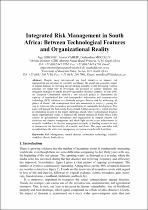 ResearchSpace
ResearchSpace
Integrated risk management in South Africa: between technological features and organisational reality
JavaScript is disabled for your browser. Some features of this site may not work without it.
- ResearchSpace
- →
- Research Publications/Outputs
- →
- Conference Publications
- →
- View Item
| dc.contributor.author |
Simonis, I

|
|
| dc.contributor.author |
Vahed, Anwar

|
|
| dc.contributor.author |
Moodley, D

|
|
| dc.date.accessioned | 2009-08-17T13:23:15Z | |
| dc.date.available | 2009-08-17T13:23:15Z | |
| dc.date.issued | 2009 | |
| dc.identifier.citation | Simonis, I, Vahed, A and Moodley, D. 2009. Integrated risk management in South Africa: between technological features and organisational reality. Information Society Technologies (IST) Africa 2009, Uganda, 6-8 May, 2009. pp 9 | en |
| dc.identifier.isbn | 978-1-905824-11-3 | |
| dc.identifier.uri | http://hdl.handle.net/10204/3532 | |
| dc.description | Information Society Technologies (IST) Africa 2009, Uganda, 6-8 May, 2009 | en |
| dc.description.abstract | Despite many international and local initiatives on disaster risk management and advances in scientific knowledge, the social and economic impact of natural disasters in emerging and developing countries is still increasing. Various activities are under way to investigate the potential of counter measures and mitigation strategies to handle the growing number of natural disasters. In June 2008, the European Commission initiated a new research project to demonstrate the capacity of standardised low cost interoperable information and communication technology (ICT) solutions to effectively mitigate disaster risk by addressing all phases of disaster risk management from risk assessment to recovery; paving the way to improved risk governance and contributing to sustainable development. This paper will present the first results from a South African perspective, which provides an interesting insight on the major challenges ahead, where technological progress meets organisational reality. It illustrates the current situation in South Africa in the context of governmental instruments and organisation to support disaster risk reduction and disaster management and sheds light on our recent achievements in scientific workflows for disaster management research. A flooding scenario is used to demonstrate the functionality of scientific workflows. The paper concludes with an outlook how the entire risk management environment can benefit from them. | en |
| dc.language.iso | en | en |
| dc.publisher | Information Society Technologies | en |
| dc.subject | Risk management | en |
| dc.subject | Hazardous events - South Africa | en |
| dc.subject | Natural disasters | en |
| dc.subject | Integrated risk management in Africa | en |
| dc.subject | IRMA | en |
| dc.subject | Environmental disaster management | en |
| dc.subject | Information technology | en |
| dc.subject | Scientific workflow | en |
| dc.subject | Disaster risk reduction | en |
| dc.subject | SW4SW | en |
| dc.subject | Flood monitoring | en |
| dc.subject | Information society technologies | en |
| dc.title | Integrated risk management in South Africa: between technological features and organisational reality | en |
| dc.type | Conference Presentation | en |
| dc.identifier.apacitation | Simonis, I., Vahed, A., & Moodley, D. (2009). Integrated risk management in South Africa: between technological features and organisational reality. Information Society Technologies. http://hdl.handle.net/10204/3532 | en_ZA |
| dc.identifier.chicagocitation | Simonis, I, Anwar Vahed, and D Moodley. "Integrated risk management in South Africa: between technological features and organisational reality." (2009): http://hdl.handle.net/10204/3532 | en_ZA |
| dc.identifier.vancouvercitation | Simonis I, Vahed A, Moodley D, Integrated risk management in South Africa: between technological features and organisational reality; Information Society Technologies; 2009. http://hdl.handle.net/10204/3532 . | en_ZA |
| dc.identifier.ris | TY - Conference Presentation AU - Simonis, I AU - Vahed, Anwar AU - Moodley, D AB - Despite many international and local initiatives on disaster risk management and advances in scientific knowledge, the social and economic impact of natural disasters in emerging and developing countries is still increasing. Various activities are under way to investigate the potential of counter measures and mitigation strategies to handle the growing number of natural disasters. In June 2008, the European Commission initiated a new research project to demonstrate the capacity of standardised low cost interoperable information and communication technology (ICT) solutions to effectively mitigate disaster risk by addressing all phases of disaster risk management from risk assessment to recovery; paving the way to improved risk governance and contributing to sustainable development. This paper will present the first results from a South African perspective, which provides an interesting insight on the major challenges ahead, where technological progress meets organisational reality. It illustrates the current situation in South Africa in the context of governmental instruments and organisation to support disaster risk reduction and disaster management and sheds light on our recent achievements in scientific workflows for disaster management research. A flooding scenario is used to demonstrate the functionality of scientific workflows. The paper concludes with an outlook how the entire risk management environment can benefit from them. DA - 2009 DB - ResearchSpace DP - CSIR KW - Risk management KW - Hazardous events - South Africa KW - Natural disasters KW - Integrated risk management in Africa KW - IRMA KW - Environmental disaster management KW - Information technology KW - Scientific workflow KW - Disaster risk reduction KW - SW4SW KW - Flood monitoring KW - Information society technologies LK - https://researchspace.csir.co.za PY - 2009 SM - 978-1-905824-11-3 T1 - Integrated risk management in South Africa: between technological features and organisational reality TI - Integrated risk management in South Africa: between technological features and organisational reality UR - http://hdl.handle.net/10204/3532 ER - | en_ZA |





